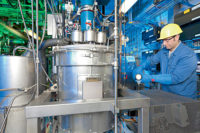In today’s world of changing consumer sensibilities and related trends such as sustainability and e-mobility, research and development has never been more important for the adhesives and sealants industry. We must be able to develop new, commercially viable products to provide the solutions our society needs to evolve.
As we’ve all seen, the events of the past two years have posed significant potential roadblocks to research and development efforts. How are companies evaluating the multiple issues involved, exploring potential solutions, and pivoting to ensure their companies remain focused on innovation in these challenging times? I recently asked key players to share their thoughts.
How have your company’s R&D efforts been impacted by COVID-19 and/or supply chain issues?

Thomas Lys, Director of Technical Services Construction, Omya, Inc.
Thomas Lys, Director of Technical Services Construction, Omya, Inc.: Our R&D efforts could be maintained during the time of the pandemic as all our technical and application labs were operating. We could continue our internal innovation projects and our collaboration with customers. Virtual communication tools were proven to be very effective during time of lockdown and COVID-19-related travel restrictions.

Vinita Sharma, Vice President, Product Management & Development, Berry Global
Vinita Sharma, Vice President, Product Management & Development, Berry Global: When faced with challenges such as the COVID-19 pandemic or supply chain issues, we approach it as an opportunity to increase our agility and creative thinking in support of our customers. During the past two years, Berry has announced several investments in new technology and equipment to meet the shifting demands of the times. We’ve taken this time to continue as consistent of a supply as possible to our customers as well as elevate our offerings where we can to further meet customer demand.

Michael Todd, Global Head of Innovation, Henkel Adhesive Technologies
Michael Todd, Global Head of Innovation, Henkel Adhesive Technologies: In our adhesives business at Henkel, we haven’t seen a slowdown in the innovation rate during the pandemic—the opposite has been the case. Since the outbreak in 2020, the demand for innovation of our customers across industries and with it the number of innovation projects has increased. Key driver for this development has been first and foremost sustainability, which is progressively dominating all the different markets we serve globally—driven by resource efficiency and CO2 reduction, by circular economy and recyclability, or by alternative material formulations and renewable raw materials. This development is also reflected in our annual R&D spend, which is constantly increasing year by year and which has reached a new record-high of about €300 million [approximately $317.7 million] in 2021.
Like many other companies, we are experiencing a high volatility in the global supply chains for years now—this development has not been limited to the pandemic. Additionally, we had to deal with the extreme weather conditions in North America with an all-time high in Force Majeures or the Suez Canal blockage and currently with the dramatic situation in Ukraine. The strong recovery in multiple industrial segments during the second half of 2020 and continued high demands for industrial and consumer goods are currently meeting short supply capacities globally. However, these challenges can be a driver for innovation as well. The pressure across the supply chains has accelerated the use of alternative raw materials such as bio-renewables or recycled materials across different formulations in our portfolio.
Last but not least, we have started operating our new Inspiration Center Düsseldorf during the pandemic in 2021, the biggest single investment in our company’s history. The €130 million-plus [~ $137.7 million] building serves as an innovation center with more than 30 laboratories, as well as a global customer center that significantly enhances our collaboration and innovation capabilities. For the first time ever, we now can showcase and connect all our technologies under one roof and offer more than 600 employees a modern and inspiring work environment reflecting new work models as well.
What end-use sectors are most prompting your development efforts?




